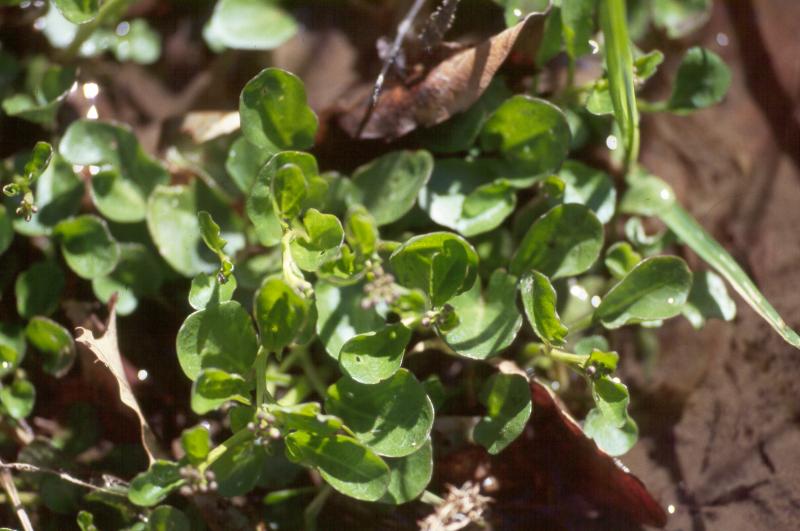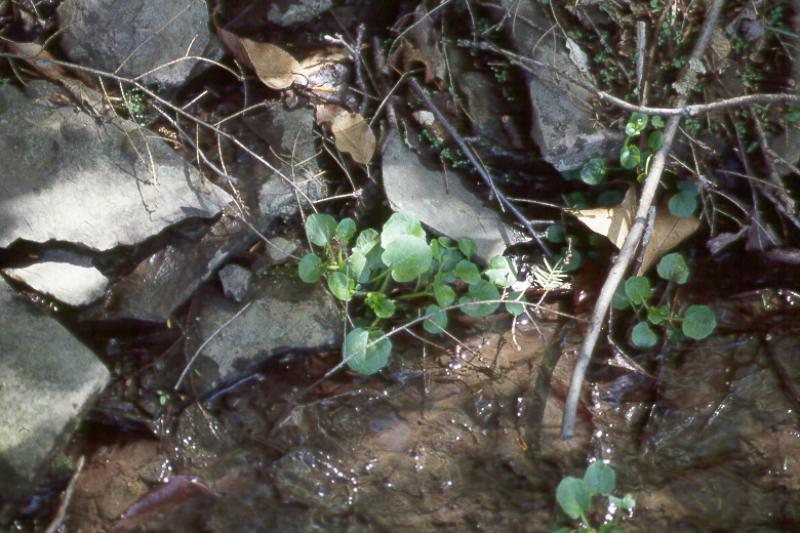Round-leaved Water Cress
Cardamine rotundifolia Michx.
- Class
- Dicotyledoneae (Dicots)
- Family
- Brassicaceae (Mustard Family)
- State Protection
- Endangered
Listed as Endangered by New York State: in imminent danger of extirpation in New York. For animals, taking, importation, transportation, or possession is prohibited, except under license or permit. For plants, removal or damage without the consent of the landowner is prohibited.
- Federal Protection
- Not Listed
- State Conservation Status Rank
- S1
Critically Imperiled in New York - Especially vulnerable to disappearing from New York due to extreme rarity or other factors; typically 5 or fewer populations or locations in New York, very few individuals, very restricted range, very few remaining acres (or miles of stream), and/or very steep declines.
- Global Conservation Status Rank
- G4
Apparently Secure globally - Uncommon in the world but not rare; usually widespread, but may be rare in some parts of its range; possibly some cause for long-term concern due to declines or other factors.
Summary
Did you know?
The leaves of mountain watercress can be eaten raw or cooked. They have a hot watercress-like flavor. Being that they are rare in New York, please don't eat our plants.
State Ranking Justification
Currently there are only five populations known with a total of less than 1000 plants. Only four additional historical locations have ever been recorded. Trends are stable and threats are low but it is expected that this plant will always be rare in the state.
Short-term Trends
Three of the five populations have been resurveyed with little change in the numbers or quality of plants.
Long-term Trends
The populations will probably remain stable for the foreseeable future since most of them are in areas where little change in the habitat is expected.
Conservation and Management
Threats
Most of the populations occur in areas where little change in habitat is expected.
Conservation Strategies and Management Practices
Since this species seems to prefer forested areas with springs and seeps an effort should be made to protect their hydrologic regime. Forested areas around the occurrences should remain intact.
Research Needs
The exact type of wetland system that this species prefers should be studied. This information could be used to help model its expected occurrence in the state.
Habitat
Habitat
A plant of sandy or muddy streamsides, beaver wetlands, spring seeps, and oxbows (New York Natural Heritage Program 2006). Springs, seeps, and stream edges (Rhoads and Block 2000). Wet soil, swamps, or running water (Gleason and Cronquist 1991). Springy places and brooksides (Fernald 1970).
Associated Ecological Communities
- Hemlock-northern hardwood forest
(guide)
A mixed forest that typically occurs on middle to lower slopes of ravines, on cool, mid-elevation slopes, and on moist, well-drained sites at the margins of swamps. Eastern hemlock is present and is often the most abundant tree in the forest.
- Intermittent stream*
(guide)
The community of a small, intermittent or ephemeral streambed in the uppermost segments of stream systems where water flows only during the spring or after a heavy rain and often remains longer, ponded in isolated pools. These streams typically have a moderate to steep gradient and hydric soils.
- Oxbow lake/pond
(guide)
The aquatic community of a small, shallow, usually stagnant lake or pond of fluvial origin that occurs in an old river meander or oxbow that has been cut off from an unconfined river or marsh headwater stream by deposition of a levee. Typically, the associated river periodically overflows this levee, restoring river water and biota to this lake type.
- Sedge meadow
(guide)
A wet meadow community that has organic soils (muck or fibrous peat). Soils are permanently saturated and seasonally flooded. The dominant herbs must be members of the sedge family, typically of the genus Carex.
- Shallow emergent marsh
(guide)
A marsh meadow community that occurs on soils that are permanently saturated and seasonally flooded. This marsh is better drained than a deep emergent marsh; water depths may range from 6 in to 3.3 ft (15 cm to 1 m) during flood stages, but the water level usually drops by mid to late summer and the soil is exposed during an average year.
- Shrub swamp
(guide)
An inland wetland dominated by tall shrubs that occurs along the shore of a lake or river, in a wet depression or valley not associated with lakes, or as a transition zone between a marsh, fen, or bog and a swamp or upland community. Shrub swamps are very common and quite variable.
* probable association but not confirmed.
Associated Species
- Acer rubrum var. rubrum (common red maple)
- Acer saccharum (sugar maple)
- Betula alleghaniensis (yellow birch)
- Cardamine pensylvanica (Pennsylvania bitter cress)
- Carex prasina (elegant drooping sedge)
- Carex scabrata (rough sedge)
- Carpinus caroliniana
- Chrysosplenium americanum (golden-carpet)
- Cornus racemosa (gray dogwood, red-panicled dogwood)
- Equisetum arvense (field horsetail, common horsetail)
- Erythronium americanum
- Gaultheria procumbens (wintergreen, teaberry)
- Glyceria canadensis (rattlesnake manna grass)
- Hydrocotyle americana (American marsh-pennywort)
- Impatiens capensis (spotted jewelweed, spotted touch-me-not)
- Iris versicolor (blue flag)
- Lycopus americanus (American bugleweed, American water-horehound)
- Maianthemum canadense (Canada mayflower)
- Mitella diphylla (two-leaved mitrewort, two-leaved bishop's-cap)
- Myosotis scorpioides (water forget-me-not)
- Onoclea sensibilis (sensitive fern)
- Ranunculus recurvatus
- Rorippa aquatica (lake water cress)
- Thalictrum thalictroides (rue-anemone)
- Tsuga canadensis (eastern hemlock)
- Typha latifolia (wide-leaved cat-tail)
- Uvularia sessilifolia (wild-oats, sessile-leaved bellwort)
- Veratrum viride (false hellebore, Indian corn lily)
- Viola sororia (common blue violet)
Range
New York State Distribution
Most of the New York populations are from the western Southern Tier, particularly in and around both the Allegheny Reservoir drainage and the Cattaragus Creek drainage. The historical record from Ontario County needs confirmation. Additional populations should be expected from the stream gorges that drain into Lake Erie as well other large river drainage systems in western New York.
Global Distribution
This mustard relative ranges from Georgia, north through the Appalachians to New York.
Identification Comments
General Description
Mountain watercress is a small, semiaquatic perennial with short trailing stems that sometimes produce runners that root at the nodes. The leaf blades are round to heart-shaped with unevenly wavy edges. The leaf stalks are about as long as the leaves and they often have one or two small lateral lobes below the main leaf blade, especially on the larger leaves. The flowers have four white petals about 1/8 to 1/4" long. The fruiting stalks are about 3/4" long and stick out from the stem. The light tan fruits are very narrow, about 3/4" long and usually infertile.
Identifying Characteristics
This low growing plant has stems that are weak or decumbent with trailing branches. The roots are fibrous. The leaves are simple, all are mostly alike, roundish to somewhat angled, and often cordate at the base. The flower petals are 5-10 mm long.
Best Life Stage for Proper Identification
For proper identification, plants should have flowers or be in fruit. To verify the identity, collect a voucher specimen.
Best Time to See
This plant flowers May through June and fruits persist until early fruit. Surveys should be conducted during the flowering and fruiting period, which fortunately means surveys can be conducted pretty much any time during the growing season.
- Vegetative
- Flowering
- Fruiting
The time of year you would expect to find Round-leaved Water Cress vegetative, flowering, and fruiting in New York.
Round-leaved Water Cress Images
Taxonomy
Round-leaved Water Cress
Cardamine rotundifolia Michx.
- Kingdom Plantae
- Phylum Anthophyta
- Class Dicotyledoneae
(Dicots)
- Order Capparales
- Family Brassicaceae (Mustard Family)
- Order Capparales
- Class Dicotyledoneae
(Dicots)
- Phylum Anthophyta
Additional Common Names
- Mountain Watercress
- Roundleaf Watercress
Comments on the Classification
The taxonomy of this species may be questioned. It may simply represent a more aquatic form of a more common Cardamine species.
Additional Resources
Best Identification Reference
Gleason, Henry A. and A. Cronquist. 1991. Manual of Vascular Plants of Northeastern United States and Adjacent Canada. The New York Botanical Garden, Bronx, New York. 910 pp.
Other References
Fernald, M.L. 1950. Gray's manual of botany. 8th edition. D. Van Nostrand, New York. 1632 pp.
Holmgren, Noel. 1998. The Illustrated Companion to Gleason and Cronquist's Manual. Illustrations of the Vascular Plants of Northeastern United States and Adjacent Canada. The New York Botanical Garden, Bronx, New York.
Mitchell, Richard S. and Gordon C. Tucker. 1997. Revised Checklist of New York State Plants. Contributions to a Flora of New York State. Checklist IV. Bulletin No. 490. New York State Museum. Albany, NY. 400 pp.
New York Natural Heritage Program. 2024. New York Natural Heritage Program Databases. Albany, NY.
Newcomb, Lawrence. 1977. Newcomb's Wildflower Guide: An Ingenious New Key System for Quick, Positive Field Identification of the Wildflowers, Flowering Shrubs, and Vines of Northeastern and North-Central North America. Little, Brown and Company. Boston.
Rhoads, Ann F. and Timothy A. Block. 2000. The Plants of Pennsylvania, an Illustrated Manual. University of Pennsylvania Press, Philadelphia, PA.
Rollins, R.C. 1993a. The Cruciferae of continental North America: Systematics of the mustard family from the Arctic to Panama. Stanford Univ. Press, Stanford, California. 976 pp.
Weldy, T. and D. Werier. 2010. New York flora atlas. [S.M. Landry, K.N. Campbell, and L.D. Mabe (original application development), Florida Center for Community Design and Research http://www.fccdr.usf.edu/. University of South Florida http://www.usf.edu/]. New York Flora Association http://newyork.plantatlas.usf.edu/, Albany, New York
Weldy, Troy W. and David Werier. 2005. New York Flora Atlas. [S.M. Landry, K.N. Campbell, and L.D. Mabe (original application development), Florida Center for Community Design and Research. University of South Florida]. New York Flora Association, Albany, NY. Available on the web at (http://newyork.plantatlas.usf.edu/).
Links
About This Guide
This guide was authored by: Stephen M. Young
Information for this guide was last updated on: August 11, 2017
Please cite this page as:
New York Natural Heritage Program. 2024.
Online Conservation Guide for
Cardamine rotundifolia.
Available from: https://guides.nynhp.org/mountain-watercress/.
Accessed July 26, 2024.

